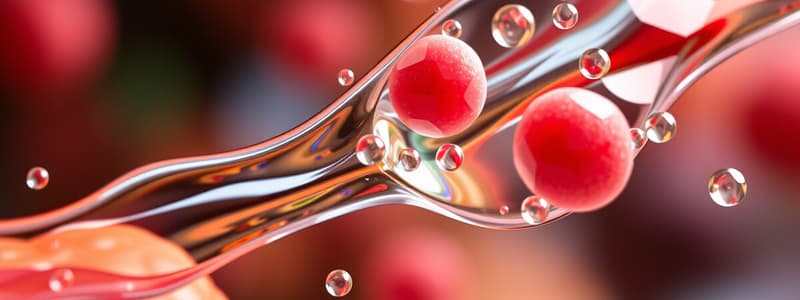Podcast
Questions and Answers
What is diffusion?
What is diffusion?
- Movement of proteins through a membrane
- Movement of water across a membrane
- Movement of particles from high concentration to low concentration (correct)
- Movement of particles from low concentration to high concentration
What is osmosis?
What is osmosis?
Diffusion of water across a selectively permeable membrane
Match the following terms with their definitions:
Match the following terms with their definitions:
Selective Permeable Membrane = A membrane that allows certain materials to pass through, but not others Facilitated Diffusion = Diffusion that uses carrier proteins to help molecules move through Phospholipid = Molecule that makes up cell membranes with a hydrophilic head and hydrophobic tails Hydrophilic = Water loving substances that easily mix with water
What is the definition of active transport?
What is the definition of active transport?
Passive transport requires energy.
Passive transport requires energy.
Iodine is an indicator for _____________.
Iodine is an indicator for _____________.
During the starch lab, molecules of _____________ diffused through the baggie.
During the starch lab, molecules of _____________ diffused through the baggie.
During the starch lab, the starch did not move out of the baggie because ______________________.
During the starch lab, the starch did not move out of the baggie because ______________________.
Both active transport and facilitated diffusion involve the use of _________________ to help molecules move through the membrane.
Both active transport and facilitated diffusion involve the use of _________________ to help molecules move through the membrane.
What is endocytosis?
What is endocytosis?
Hypertonic solutions have a lower solute concentration than the cell.
Hypertonic solutions have a lower solute concentration than the cell.
What process involves the engulfing of large particles by a cell?
What process involves the engulfing of large particles by a cell?
What is the primary function of ATP in cellular processes?
What is the primary function of ATP in cellular processes?
Flashcards
Diffusion
Diffusion
Movement of particles from a region of high concentration to a region of low concentration. Leads to equilibrium. Think of a drop of dye spreading in water.
Osmosis
Osmosis
Specific type of diffusion where water moves across a selectively permeable membrane from high to low water concentration. Helps keep cells balanced.
Selectively Permeable Membrane
Selectively Permeable Membrane
A barrier that allows some substances to pass through but blocks others. Controls what enters and exits a cell.
Facilitated Diffusion
Facilitated Diffusion
Signup and view all the flashcards
Passive Transport
Passive Transport
Signup and view all the flashcards
Active Transport
Active Transport
Signup and view all the flashcards
Exocytosis
Exocytosis
Signup and view all the flashcards
Endocytosis
Endocytosis
Signup and view all the flashcards
Phospholipid
Phospholipid
Signup and view all the flashcards
Hydrophilic
Hydrophilic
Signup and view all the flashcards
Hydrophobic
Hydrophobic
Signup and view all the flashcards
Hypotonic Solution
Hypotonic Solution
Signup and view all the flashcards
Hypertonic Solution
Hypertonic Solution
Signup and view all the flashcards
Study Notes
Cell Transport Concepts
- Diffusion: Movement of particles from an area of high concentration to an area of low concentration, establishing equilibrium.
- Osmosis: Specifically refers to the diffusion of water through a selectively permeable membrane, critical for maintaining cell homeostasis.
- Selectively Permeable Membrane: A barrier that only allows certain substances to pass through while restricting others, important for controlling cellular environments.
Types of Transport
- Facilitated Diffusion: Uses carrier proteins to assist the movement of molecules across the membrane from high to low solute concentration without energy expenditure.
- Passive Transport: Diffusion across a biological membrane with no energy cost; includes diffusion, osmosis, and facilitated diffusion.
- Active Transport: Movement of substances against their concentration gradient using specific transport proteins and ATP, crucial for nutrient uptake and waste removal.
Vesicular Transport
- Exocytosis: Secretion process where vesicles fuse with the plasma membrane to release molecules outside the cell.
- Endocytosis: Intake of extracellular substances through vesicle formation from the plasma membrane, allowing cells to engulf materials.
Phospholipid Structure
- Phospholipid: Composed of a hydrophilic "head" (water-attracting) and two hydrophobic "tails" (water-repelling), forming the basis of cellular membranes.
- Hydrophilic: Attracted to water; found in the head of phospholipids.
- Hydrophobic: Repellent to water; characterizes the tails of phospholipids.
Solutions and Cell Behavior
- Hypotonic Solution: Lower solute concentration than inside the cell; leads to cell swelling as water enters.
- Hypertonic Solution: Higher solute concentration outside the cell; causes cell shrinkage as water leaves.
- Isotonic Solution: Equal solute concentration inside and outside the cell, maintaining cell shape without net movement of water.
Transport Mechanisms Insights
- Integral Proteins: Span the entire lipid bilayer, involved in transport and communication across the membrane.
- Peripheral Proteins: Located on the membrane's surface, lacking penetration through the bilayer; serve as enzymes and signaling molecules.
- Bulk Transport: Includes endocytosis and exocytosis to transport large molecules and particles across the cell membrane.
Additional Processes
- Pinocytosis: A form of endocytosis that specifically involves the uptake of liquid from the surrounding environment.
- Phagocytosis: A specialized type of endocytosis that engulfs large particles or even other cells, vital for immune response.
Lab Context
- Iodine as an Indicator: Useful for detecting the presence of starch, illustrating the principles of diffusion in a lab setup.
- Starch Movement: Starch remains in a baggie during experiments because its large size prevents it from diffusing out through the membrane.
Studying That Suits You
Use AI to generate personalized quizzes and flashcards to suit your learning preferences.





